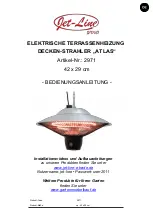
LP-551 Rev. 3.9.16
36
B. Check Inlet Gas Pressure
The gas valve is equipped with an inlet gas pressure tap that can
be used to measure the gas pressure to the unit. To check gas
pressure, perform the steps listed below:
1.
IMPORTANT!
Before you connect to the inlet pressure, shut
off the gas and electrical power to unit.
2. Loosen the pressure tap with a small screwdriver. Refer to
Figure 27 for location.
3. Each unit is equipped with a needle valve that will accept a
5/16 ID hose to connect to a digital manometer or liquid gauge
to measure incoming pressure from 0-35” w.c. See Figure 27.
4. Turn on the gas and power up the unit.
5. Put the unit into manual test mode (details on test mode are
in Part 10). In test mode, monitor pressure to assure it does not
drop below 1 inch from its idle reading. If gas pressure is out
of range or pressure drop is excessive, contact the gas utility,
gas supplier, qualified installer, or service agency to determine
correct action that is needed to provide proper gas pressure to
the unit. If Gas Pressure is within normal range proceed to Step
6.
6. Exit test mode, then turn power off and shut off gas supply at
the manual gas valve before disconnecting the hose from the
gas monitoring device. Tighten screw on the pressure tap and
turn gas on. Check for leaks with soapy solution. Bubbles will
appear on the pipe to indicate a leak is present.
Never use an open flame (match or lighter) to check for gas
leaks. Use a soapy solution to test connection. Failure to use
a soapy solution test or check gas connection for leaks can
result in substantial property damage, severe personal injury,
or death.
Use two wrenches when tightening gas piping at the boiler: One
to prevent the boiler gas line from turning. Failure to prevent
the boiler gas connection from turning could result in damage
to the gas line components, substantial property damage,
severe personal injury, or death.
CSA or UL listed flexible gas connections can be used when
installing the boiler. Flexible gas connections have different
capacities and must be sized correctly for the connected boiler
firing rates. Consult with the flex line supplier to assure the
line size is adequate for the job. Follow local codes for proper
installation and service requirements.
Ensure the pressure tap screw is properly tightened to prevent
gas leaks. Failure to do so could cause substantial property
damage, severe personal injury, or death.
The gas piping must be sized for the proper flow and length
of pipe to avoid pressure drop. The gas meter and regulator
must be properly sized for the total gas load. If you experience
a pressure drop greater than 1” w.c. (.87 kPa), the meter,
regulator or gas line may be undersized or in need of service.
You can attach a manometer to the incoming gas drip leg after
removing the cap. The gas pressure must remain between
3.5” (.87 kPa) and 14” (3.5 kPa) during stand-by (static) mode
and while in operating (dynamic) mode.
If an in-line regulator is used, it must be a minimum of 10 feet
from the boiler. It is very important that the gas line is properly
purged by the gas supplier or utility. Failure to properly purge
the lines, or improper line sizing, will result in ignition failure.
This problem is especially noticeable in NEW LP installations
and empty tank situations. This situation can also occur when
a utility company shuts off service to an area to provide
maintenance to their lines. This gas valve must not be replaced
with a conventional gas valve under any circumstances.
DO NOT adjust or attempt to measure gas valve outlet
pressure. The gas valve is factory-set for the correct outlet
pressure and requires no field adjustment. Attempts by the
installer to adjust or measure the gas valve outlet pressure
could result in damage to the valve and cause substantial
property damage, severe personal injury, or death.
Ensure that the high gas pressure regulator is as least 6 – 10
feet upstream of the appliance. Failure to do so could result
in substantial property damage, severe personal injury, or
death.
Table 18 -
Gas Pipe Sizing / BTU’s per Hour
Summary of Contents for EP-220 VWH
Page 33: ...LP 551 Rev 3 9 16 33 Figure 24 Cascade Master and FollowerWiring ...
Page 34: ...LP 551 Rev 3 9 16 34 Figure 25 Internal Connection Diagram ...
Page 57: ...LP 551 Rev 3 9 16 57 Figure 30 Combustion System Replacement Parts 220kBTU Model ...
Page 58: ...LP 551 Rev 3 9 16 58 Figure 31 Combustion System Replacement Parts 299 399kBTU Models ...
Page 59: ...LP 551 Rev 3 9 16 59 Figure 32 Replacement Parts All Models ...
















































